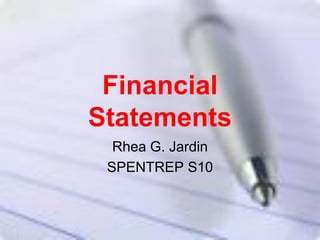Financial statements sr
•
2 gostaram•660 visualizações
Financial Statements - Special Report
Denunciar
Compartilhar
Denunciar
Compartilhar
Baixar para ler offline

Recomendados
Recomendados
Mais conteúdo relacionado
Mais procurados
Mais procurados (20)
M6 L1 Financial Documents Used in a Small Business

M6 L1 Financial Documents Used in a Small Business
Semelhante a Financial statements sr
Semelhante a Financial statements sr (20)
Meeting 4 - Cash management (Financial Management)

Meeting 4 - Cash management (Financial Management)
Basic Accounting Principles session 1 by Dino Leonandri

Basic Accounting Principles session 1 by Dino Leonandri
Finance for non finance managers module 1 financial accounting basics

Finance for non finance managers module 1 financial accounting basics
Mais de rgjardin (6)
Financial statements sr
- 1. Financial Statements Rhea G. Jardin SPENTREP S10
- 2. Three (3) Financial Statements The financial statements (FS) show the financial health of a business 1. Profit and Loss 2. Cash Flow 3. Balance Sheet
- 3. Profit and Loss Statement • Summarizes the revenues, costs and expenses incurred during a specific period of time (quarterly, fiscal, year) • Provides information that shows the ability of a company to generate profit by increasing revenue and decreasing costs • Also known as “income statement” or “income and expense statement”
- 4. Profit and Loss Statement
- 5. Cash Flow Statement Cash Flow: • A revenue or expense stream that changes a cash account over a given period • Essential to solvency of a company Statement of Cash Flow: • Shows the amount of cash generated and used in a given period • Indication of a company’s financial strength • It helps investors see if a company is having trouble with cash
- 6. Cash Flow Statement Cash Activities (inflows / outflows): 1. Operations - Depreciation expenses - Deferred taxes - Account receivables / Account payables 2. Investing - Investing of excess cash in different investments (stocks/bonds) - Buying or selling of subsidiaries - Acquisition/dispose of physical property such as PPE 3. Financing - Long term liabilities - Stockholders’ equity - Dividend payments
- 8. Cash Flow Statement Four (4) steps in managing cash flow 1. Measuring cash flow - Prepare cash flow projections - Know when payments, interest earnings, collections and other sources are going to get in - Detailed knowledge of amounts and dates of upcoming cash outlays (rent, inventory, wages, utilities, debt payments) 2. Improving receivables / speed of collection - Offer discounts who pay bills rapidly - Ask for deposit payments at the time of order - Require credit checks on noncash customers - Track accounts receivables to identify and avoid slow-paying customers
- 9. Cash Flow Statement 3. Managing payables - Take full advantage of creditor payment terms - Use electronic fund transfer on the last day they are due - Communicate with your suppliers if you need to delay payments - Carefully consider vendors’ offers of discounts for earlier payments - Don’t always focus on lowest price when choosing suppliers – consider flexible payment terms 4. Surviving shortfalls - Be aware of cash shortfalls as early and as accurately as possible - Choose the bills you’ll pay carefully (payroll, crucial suppliers)
- 10. Balance Sheet • Summarizes a company’s assets, liabilities and shareholders’ equity at a specific point in time • A tool to calculate the net worth of a business (financial ratios) • The 3 segments give investors an idea as to what the company owns and owes, as well as the amount invested by the shareholders • It is called such because the two sides balance out Assets = Liabilities + Shareholders’ Equity
- 11. Balance Sheet
- 12. Sources • http://www.investorwords.com • The Ins and Outs of Cash Flow Statements http://www.entrepreneur.com/article/178302 • How to better manage your cash flow, http://www.entrepreneur.com/article/66008 • http://www.investopedia.com